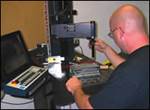Cutting Tools For High Speed Milling Of Aluminum
Go with the flow—chip flow, that is. The uninterrupted flow of the soft aluminum chip determines the design of the end mills that Metlfab uses.
The faster you mill a pocket in a billet of any of the commonly machined aluminum alloys, the more important it is for the cutting tool to provide a wide and easy path for the chip to escape. In fact, tools that have fewer flutes tend to be more productive for this very reason—the wider flute spacing provides more clearance. High speed machining of aluminum is one application in which a one-flute end mill may actually be the most productive.
Netherlands-based Seco-Jabro Tools supplies a one-flute solid carbide end mill. Seco-Jabro’s U.S. agent, Seco-Tesco (Hayes, Virginia), has provided much of the tooling that performs well in Metlfab’s new-from-the-ground-up process for high speed machining of aluminum (detailed in the article under "Editor Picks" at right). Metlfab did not choose the one-flute tool; the asymmetrical cutter demands off-line balancing for use at high spindle speeds, and the shop didn’t want to implement this extra step. However, the design of a Seco-Jabro two-flute tool used at Metlfab illustrates some of the same features. Eric Gardner, Seco-Tesco’s product manager for milling, explains how the tool design assists in milling aluminum rapidly.
Chip flow is paramount, he says. In high speed machining of other materials—most notably the tool steels that figure into die/mold applications—a major challenge is the heat. In high speed machining of aluminum, by contrast, a major challenge is the tendency of the soft material to adhere to the cutting edge. The die/mold high speed machining end mill may use a coating that acts as a thermal barrier. However, if the end mill for aluminum uses a coating at all, it is likely to use one chosen more for its lubricity than for its thermal effect. More significantly, the geometry of the tool facilitates chip flow—essentially by keeping the tool out of the chip’s way.
For example, the flute design avoids sudden changes in the path of the chip. In this, the flute follows a principal similar to that of the tool path in high speed machining. While the tool path for high feed rates features rounded corners and gradual changes in direction to avoid shocking the tool, the tool that mills aluminum at high speeds features a smooth rake face and a somewhat slower helix for a similar reason—to avoid sharp transitions that might impede the movement of the chip.
The tool also features deep flutes that provide the chip with gullies that are more open. The value of this clearance for the chip is the reason why a one-flute tool may be successful. Having just one flute allows the gully corresponding to the flute to be ground past the tool’s centerline—a feature that can allow the 13-mm version of this tool to operate at a feed of 0.060 ipt, Mr. Gardner says. A two-flute tool obviously can’t permit so much flute clearance, but the two-flute end mill used in aluminum might have gullies so deep that the core of the tool accounts for only 20 percent of the tool’s diameter.
Such a tool may appear too delicate for high metal removal rates. Appearances can be deceiving, however. Mr. Gardner says a more conventional tool that appears more solid is likely to trap aluminum chips quickly, therefore performing much less effectively in the aluminum milling application.
Plus, Metlfab applies tooling such as this in a way that optimizes its rigidity. With machines having 145 tool magazine positions devoted to standard tooling, there is room within the shop’s standard kit to stock the same tool variety at different lengths. This gives the shop’s programmers freedom to select the shortest tool length that a particular cut will allow. Mr. Gardner sees this as an example of one more vital factor in any cutting tool’s success: having a process in place around the tool that is able to fully realize the tool’s potential.
Related Content
All-Around Mill Improves Productivity and Cost for Valve Job
Adopting a mill with a double-negative rake and pockets compatible with multiple insert geometries enabled Progressive Metal Service to increase feed and lower scrap rates for a valve.
Read MoreHow to Mitigate Chatter to Boost Machining Rates
There are usually better solutions to chatter than just reducing the feed rate. Through vibration analysis, the chatter problem can be solved, enabling much higher metal removal rates, better quality and longer tool life.
Read MoreNew Machining Technology Works With Old to Restore WWII Submarine
A set of donated boring bars that can be used in a 1954 boring head will enable volunteer machinists to recreate a pair of binoculars for the USS Pampanito.
Read MoreChoosing Your Carbide Grade: A Guide
Without an international standard for designating carbide grades or application ranges, users must rely on relative judgments and background knowledge for success.
Read MoreRead Next
Everything Changes
Through a sweeping transition to high speed machining, a Maryland contract shop realizes its goal of same-day, "in by 9, out by 5" turnaround.
Read MoreThe Cut Scene: The Finer Details of Large-Format Machining
Small details and features can have an outsized impact on large parts, such as Barbco’s collapsible utility drill head.
Read More3 Mistakes That Cause CNC Programs to Fail
Despite enhancements to manufacturing technology, there are still issues today that can cause programs to fail. These failures can cause lost time, scrapped parts, damaged machines and even injured operators.
Read More
.jpg;width=70;height=70;mode=crop)


















.png;maxWidth=300;quality=90)








